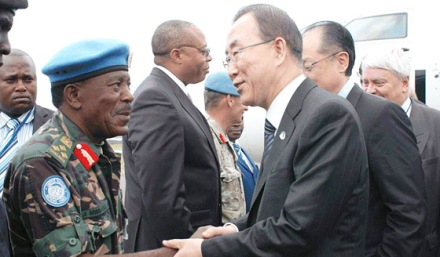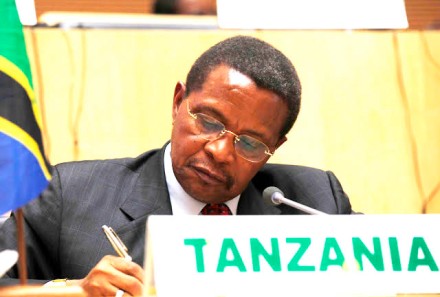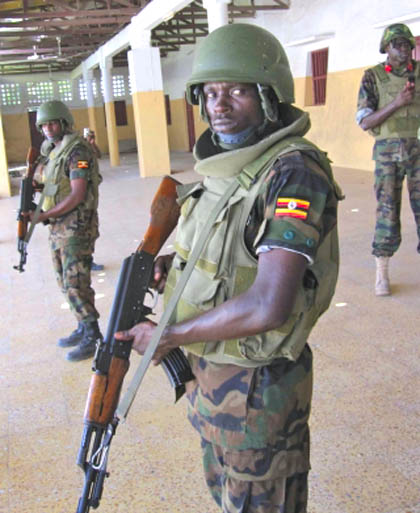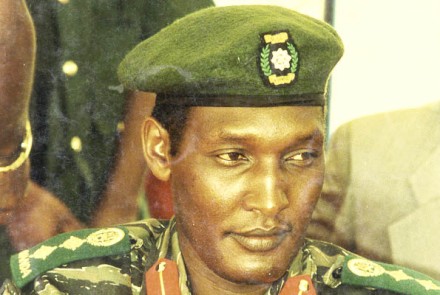CRISIS IN THE GREAT LAKES 3: A Congo-based Rebel Chief Visiting Tanzania Disappears And Hell Breaks Loose
MANY questions arise from the second part of this series, CRISIS IN THE GREAT LAKES 2: Is Tanzania South Africa’s Trojan Horse? And Why Did Mandela Like Kagame But Zuma Doesn’t?
You could ask whether:
•In suggesting that the Paul Kagame government talk to the Democratic Forces for the Liberation of Rwanda (FDLR) DR Congo-based rebels, knowing well Kigali would go ballistic, was Tanzania’s President Jakaya Kikwete baiting Rwanda?

Tanzania’s Brig. Mwakibola, commander of the UN’s intervention force in DRC, with Secretary-Gen Ban Ki Moon in Goma earlier in 2013.
•Did Rwanda play into Tanzania’s hands with its angry rebuke, and thus enable Dar es Salaam to expel Rwandans from its northwest region using the “rift” between the two countries as the perfect cover?
•When Kagame said he would “hit” those who seemed to be siding with the FDLR (most of whose members are blamed for the 1994 genocide in Rwanda) by trying get a place for it at negotiation tables, did he mean he would hammer Tanzania, which together with South Africa, comprises the bulk of the UN’s Force Intervention Brigade (FIB) in the DRC?
•Rwanda has always been critical of the UN peacekeeping mission in DRC MONUSCO, and lately its offshoot FIB. If, as some in Tanzania believe, the M23 rebels are backed heavily by Rwanda, what did it expect would happen to their relations with Kigali when its forces clashed – as they have already done – with rebels?
•And if Tanzania is just a proxy of South Africa in the latter’s “war” against Rwanda, why is it playing along? And what does South Africa expect to gain from bringing down the Kagame government? And why then has it chosen DRC to fight this fight?

President Kikwete at the African Union summit in May where he urged Rwanda and Uganda to talk to their DRC-based rebels
The questions are endless. Some facts, though, do help shed light on the drama that is evolving in the jungles of eastern DRC.
By April, it had been well established that Tanzania would contribute troops to the UN’s FIB, which had been freshly minted and given rare powers, for a UN force, to pursue and shoot back. Tanzania too was to provide the leadership. Veteran Tanzania officer Brigadier James Aloys Mwakibola was appointed to head FIB.
Brig. Mwakibola’s choice was an interesting one. In October 2011 when the East African joint military exercises were held in Rwanda, Brig. Jaques Musemakweli from the Rwanda Defence Forces (RDF) and Brig. Mwakibolwa led the exercises. So while he probably knows the RDF’s methods well and could prove a valuable hand against it, he also has contacts with the Rwandese that can help prevent the worst.
In any event, some time in April something that seems to feeding a significant part of the current bitterness between Rwanda and Tanzania happened.
One of the FDLR’s top commanders Gen. Stanislas Nzeyimana, aka

Regional leaders at the Great Lakes summit in Kampala, September 5: The Tanzanian and Rwandan leaders seemed to have stayed as far away from each other as was possible (Photo Stephen Wandera/Daily Monitor)
Deogratias Bigaruka Izabayo, who had been in Tanzania for some months, entered Burundi from Tanzania at the Kigoma border point so he could head back to his base in eastern DRC.
What is known, and that the FDLR acknowledges, is that Nzeyimana vanished. One view doing the rounds is that he had been trailed by Rwandan intelligence while he was in Tanzania, and the Rwandese pounced as soon as he crossed the border, grabbed him, and spirited him off to a secret location in Kigali.
While in Tanzania, Nzeyimana met several top political and security leaders including, it is alleged, President Kikwete. It has been difficult to confirm this beyond doubt because, naturally, the Tanzanians are reluctant to admit that they hosted a senior commander of what internationally some consider to be a genocidal group. Be that as it may, Dar es Salaam is said to be “totally pissed off” with Rwanda over the disappearance of Nzeyimana.
But why would Tanzania hobnob with the FDLR? For one, according to informed sources, Tanzania does genuinely believe that there is moderate faction that has emerged within the FDLR, and that it can talk productively with the Kagame government.

Regional leaders at the Great Lakes summit in Kampala, September 5: The Tanzanian and Rwandan leaders seemed to have stayed as far away from each other as was possible (Photo Stephen Wandera/Daily Monitor)
There is also speculation that ahead of sending its troops into FIB, Tanzania was wary of getting buried in the DRC’s notorious political graveyard. So it reached out to the FDLR to ensure, if nothing else, that it doesn’t attack its troops.
It would seem then that when in May at the African Union summit in the Ethiopian capital Addis Ababa, Kikwete suggested that Rwanda and Uganda talk to their DRC-based rebels, he had reasonable expectations that the moderate faction of the FDLR would come to the table, in Rwanda’s case. Or if it all backfired, as it eventually did, at least when the Tanzanians arrived in eastern DRC, they would be in the good books of the FDLR and Uganda’s Allied Democratic Front (ADF) rebels who would seem them as honest brokers, improving their chances of making a success of the mission.
From Kigali and Kampala, though, the view of Tanzania’s game looks different. In the case of Rwanda, there have been suggestions that Nzeyimana was “squeezed” during interrogation, and he spilled beans that confirm Tanzania has unholy plans against Rwanda. That, sources say, explains why Rwanda’s response to Kikwete’s suggestion for talks with the FDLR was unusually sharp.
Likewise, these same people think that the expulsion of Rwandans from the northwest of Tanzania, is part of a plan by Kikwete and his allies to clear the area and establish bases there for the National Democratic Congress (NDC), a dissident group affiliated to exiled former Rwanda Army chief Gen. Kayumba Nyamwasa and intelligence boss Col. Patrick Karegeya. They reason that because Kikwete’s term is coming to an end in 2015, he is allegedly “in a rush to help his friends [Kayumba and Karegeya] set up shop in East Africa before he retires”. Kayumba and Karegeya are based in South Africa.
Therefore, to these sources, what Tanzania is trying to do is forge a united front between the “Tutsi-led” NDC and the so-called moderate faction of FDLR – a predominantly Hutu group.
However, going by its history, and the record of Tanzania’s ruling partyChama Cha Mapinduzi (Party of Revolution – CCM), though that would be a step too far.
Which is why, some analysts think that Kikwete is more narrowly focused on scoring political points at home. The union between Tanganyika mainland the Zanzibar, which form Tanzania, has been creaking. The tensions between the mainland and Zanzibar have reached their worst during the rule of Kikwete.

Uganda AMISOM troops in Somalia: There can be glory in this business, except that it has been elusive for peacekeepers in central Africa
To avert the perennial violence that plagued elections in Zanzibar, as the 2010 polls approached, Kikwete arm-twisted CCM to do a deal with Zanzibar’s main Opposition party, the Civic United Front (CUF) for a power-sharing arrangement. That helped prevent previous violence and gave CUF a share of the political spoils.
But CCM purists saw it is a subversion of the spirit of the 49-year-union, and said it would give new fuel to old secessionist sentiment on the island.
At the same time, in the 2010 election CCM suffered its worst electoral show against the opposition. In the 1995 election, for example, the main opposition party Chadema won only four of the 269 seats in Parliament. In 2010, that rose to 48 seats. It swept a couple of large urban areas, the northern regions like Arusha, and some of the constituencies in the west around Mbeya.
Then mid this year, Tanzania’s constitution review commission published its report. It proposed a national government for Zanzibar led by a local president, and another one for the mainland (Tanganyika), and then a big man or woman at the top of both, who would be a federal president. It has opened an uncertain future in Tanzania, and as one commentator put it, as decision time closes on the new constitution, the “game could get away from CCM”.
Because of this, there are those who see Kikwete’s plunge into the DRC, and his flap with Rwanda as a ruse to shore up nationalist sentiment in the west (where expulsions of Rwandese might play well among hardline nationalists) and the north of Tanzania where CCM is losing its grip. A prominent role in the UN peace mission in DRC, especially if Tanzania can take the kind of credit that Uganda, Burundi, and Kenya are claiming in defeating Al-Shabaab in Somalia and stabilising the Horn of Africa nation after 20 years of chaos, then CCM would come out of it smelling like roses.
In that sense, Rwanda and DRC would just be pawns on Kikwete’s chessboard. Except that in real life matters rarely turn out so neatly.
GREAT LAKES CRISIS PARTS 4, 5, AND 6 TO BE CONTINUED…


